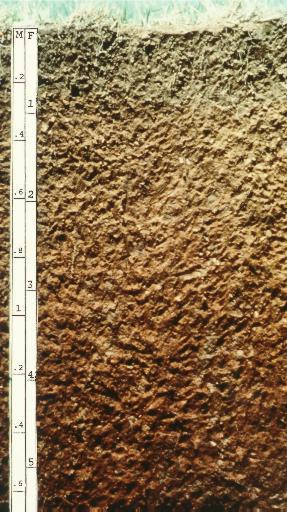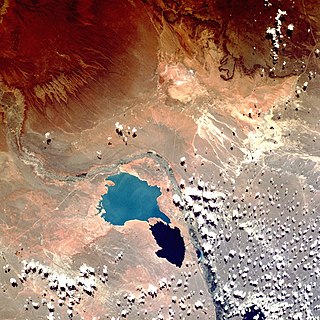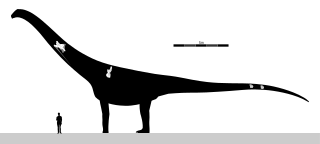
Alfisols are a soil order in USDA soil taxonomy. Alfisols form in semi-arid to humid areas, typically under a hardwood forest cover. They have a clay-enriched subsoil and relatively high native fertility. "Alf" refers to aluminium (Al) and iron (Fe). Because of their productivity and abundance, Alfisols represent one of the more important soil orders for food and fiber production. They are widely used both in agriculture and forestry, and are generally easier to keep fertile than other humid-climate soils, though those in Australia and Africa are still very deficient in nitrogen and available phosphorus. Those in monsoonal tropical regions, however, have a tendency to acidify when heavily cultivated, especially when nitrogenous fertilizers are used.

The Neuquén Group is a group of geologic formations found in Argentina. Rocks in the Neuquén Group fall within the Cenomanian to early Campanian stages of the Late Cretaceous Period. It overlies the older Lohan Cura Formation and is itself overlain by the younger Allen Formation of the Malargüe Group, separated from both by unconformities, dated to 98 and 79 Ma respectively.

Talenkauen is a genus of basal iguanodont dinosaur from the Campanian or Maastrichtian age of the Late Cretaceous Cerro Fortaleza Formation, formerly known as the Pari Aike Formation of Patagonian Lake Viedma, in the Austral Basin of Santa Cruz, Argentina. It is based on MPM-10001A, a partial articulated skeleton missing the rear part of the skull, the tail, and the hands. The type and only species is Talenkauen santacrucensis.
The Huincul Formation is a geologic formation of Late Cretaceous age of the Neuquén Basin that outcrops in the Mendoza, Río Negro and Neuquén Provinces of northern Patagonia, Argentina. It is the second formation in the Río Limay Subgroup, the oldest subgroup within the Neuquén Group. Formerly that subgroup was treated as a formation, and the Huincul Formation was known as the Huincul Member.
The Bajo de la Carpa Formation is a geologic formation of the Neuquén Basin that crops out in northern Patagonia, in the provinces of Río Negro and Neuquén, Argentina. It is the oldest of two formations belonging to the Río Colorado Subgroup within the Neuquén Group. Formerly, that subgroup was treated as a formation, and the Bajo de la Carpa Formation was known as the Bajo de la Carpa Member.

Puertasaurus is a genus of sauropod dinosaur that lived in South America during the Late Cretaceous Period. It is known from a single specimen recovered from sedimentary rocks of the Cerro Fortaleza Formation in southwestern Patagonia, Argentina, which probably is Campanian or Maastrichtian in age. The only species is Puertasaurus reuili. Described by the paleontologist Fernando Novas and colleagues in 2005, it was named in honor of Pablo Puerta and Santiago Reuil, who discovered and prepared the specimen. It consists of four well-preserved vertebrae, including one cervical, one dorsal, and two caudal vertebrae. Puertasaurus is a member of Titanosauria, the dominant group of sauropods during the Cretaceous.
Ausktribosphenidae is an extinct family of australosphenidan mammals from the Early Cretaceous of Australia and mid Cretaceous of South America.

Orkoraptor is a genus of medium-sized megaraptoran theropod dinosaur from the late Cretaceous Period of Argentina. It is known from incomplete fossil remains including parts of the skull, teeth, tail vertebrae, and a partial tibia. The specialized teeth resemble those of some maniraptoriform theropods, namely the deinonychosaurs and compsognathids. This and other anatomical features led the authors who described it to suggest that it was a maniraptoran coelurosaur. However, subsequent studies found it to be a megaraptoran. Found in the Cerro Fortaleza Formation of Southern Patagonia, it is one of the southernmost carnivorous dinosaurs known from South America.
The Magallanes Basin or Austral Basin is a major sedimentary basin in southern Patagonia. The basin covers a surface of about 170,000 to 200,000 square kilometres and has a NNW-SSE oriented shape. The basin is bounded to the west by the Andes mountains and is separated from the Malvinas Basin to the east by the Río Chico-Dungeness High. The basin evolved from being an extensional back-arc basin in the Mesozoic to being a compressional foreland basin in the Cenozoic. Rocks within the basin are Jurassic in age and include the Cerro Toro Formation. Three ages of the SALMA classification are defined in the basin; the Early Miocene Santacrucian from the Santa Cruz Formation and Friasian from the Río Frías Formation and the Pleistocene Ensenadan from the La Ensenada Formation.
The Griman Creek Formation is a geological formation in northern New South Wales and southern Queensland, Australia whose strata date back to the Albian-Cenomanian stages of the mid-Cretaceous. It is most notable being a major source of opal, found near the town of Lightning Ridge, New South Wales. Alongside the opal opalised fossils are also found, including those of dinosaurs and primitive monotremes.
The Bajo Barreal Formation is a geological formation in the Golfo San Jorge Basin of Chubut and Santa Cruz, Argentina whose strata date back to the Middle Cenomanian to Late Turonian. The formation was first described by Teruggi & Rossetto in 1963. The sandstones, claystones, mudstones, conglomerates and tuff were deposited in a fluvial environment. The upper part of formation is laterally equivalent to the Yacimiento El Trébol and Meseta Espinosa Formation and the lower part to the Laguna Palacios, Cañadón Seco and Comodoro Rivadavia Formations. The Bajo Barreal Formation is a reservoir rock in the Golfo San Jorge Basin.

Austrocheirus is an extinct genus of theropod dinosaur that lived during the Late Cretaceous period. It was named and described by Martin Ezcurra, Federico Agnolin and Fernando Novas in 2010. It contains the type species Austrocheirus isasii. The generic name means "southern hand". The specific epithet honours discoverer and preparator Marcelo Pablo Isasi.
The Cerro Fortaleza Formation, in older literature described as Pari Aike Formation, is a Late Cretaceous geologic formation of Campanian to Maastrichtian age of the Austral Basin in southern Patagonia, Argentina.

The Malargüe Group is a group of geologic formations of the Neuquén Basin of the Mendoza, Neuquén, Río Negro and La Pampa Provinces in northern Patagonia, Argentina. The formations of the Malargüe Group range in age between the middle Campanian to Deseadan, an Oligocene age of the SALMA classification, straddling the Cretaceous–Paleogene boundary, about 79 million to 30 million years in age. The group overlies the older Neuquén Group, separated by an unconformity dated to 79 Ma. The rocks of the Malargüe Group comprise both marine and continental deposits which are over 400 m (1312 ft) thick in total.

Leinkupal is a genus of diplodocine sauropod known from the Early Cretaceous of the Bajada Colorada Formation, southeastern Neuquén Basin in the Neuquén Province of Argentina. It contains a single species, Leinkupal laticauda.
The Bajada Colorada Formation is a geologic formation of the southern Neuquén Province in the Neuquén Basin of northern Patagonia, Argentina. The formation belongs to the Mendoza Group and is Late Berriasian to Early Valanginian in age. The formation is renowned for preserving fossil remains of Bajadasaurus pronuspinax, a genus of dicraeosaurid dinosaurs named after the formation.
Tralkasaurus is a genus of abelisaurid dinosaur from the Huincul Formation from Río Negro Province in Argentina. The type and only species is Tralkasaurus cuyi, named in 2020 by Mauricio Cerroni and colleagues based on an incomplete skeleton. A medium-sized abelisaurid, Tralkasaurus exhibits a conflicting blend of characteristics found among the early-diverging abelisauroids with others that characterize the highly specialized clade Brachyrostra, and thus its position within the clade is poorly-resolved.
Kaikaifilusaurus is an extinct genus of rhynchocephalians in the family Sphenodontidae from the Late Cretaceous of South America. Fossils of the genus were found in Cenomanian sediments of the Candeleros Formation and Turonian layers of the Huincul Formation, both of the Neuquén Basin and the Albian strata of the Cerro Barcino Formation in the Cañadón Asfalto Basin, all in Patagonia, Argentina. The genus contains two species, K. minimus and the type species K. calvoi.
Perforissidae is an extinct family of planthoppers. They are considered to belong to the group of "Cixiidae-like" planthoppers. Species are known from the Early to Late Cretaceous of Eurasia, North America and South America. The family was named by Shcherbakov in 2007

Meraxes is a genus of large carcharodontosaurid theropod dinosaur from the Late Cretaceous Huincul Formation of Patagonia, Argentina. The genus contains a single species, Meraxes gigas.












